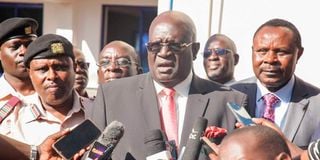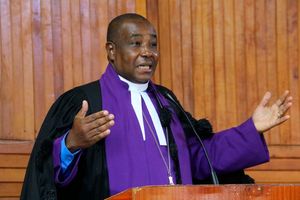Premium
Junior high: Why Magoha’s new classes plan falls short

Education Cabinet Secretary George Magoha speaking to journalists. Secondary schools require about 30,000 classrooms among other facilities to be ready to admit the 1.4 million learners in January next year when the CBC rolls out in junior secondary.
Secondary schools require about 30,000 classrooms among other facilities to be ready to admit the 1.4 million learners in January next year when the competency-based curriculum (CBC) rolls out in junior secondary.
According to official data, the double intake of the CBC and 8-4-4 learners will create a shortfall of 1,489,144 places in secondary schools. With the recommended class size of between 45 and 50 students, these would require 29,783 more classrooms which is way beyond the 10,000 earmarked by the government for completion by end of next month. With their current population, many secondary schools are also greatly over-enrolled.
According to Education Cabinet Secretary George Magoha, the government is also banking on private schools to complement their efforts and put up 5,000 more classrooms. So far, only 1,200 have been completed by private schools. Inspection of the classrooms in private schools, for compliance with health and safety guidelines, is ongoing.
Prof Magoha, however, dismissed concerns over preparedness and insisted that there will be no crisis and that whichever government will take over after the August General Election will continue to expand infrastructure in secondary schools.
“Don’t expect us to finish. If we finish, what’s the other one (government) going to do?” the CS posed when he commissioned a CBC classroom at Mwiki Secondary School in Nairobi County.
Struggled to deliver
The Ministry of Education will roll out the second phase of CBC classrooms at the end of this week although it has struggled to deliver the 6,497 classrooms in Phase I that it had initially targeted to complete before the start of national examinations in March. A few classrooms are still incomplete.
“The failure of the Ministry of Education to develop a costed plan for the implementation of CBC is the biggest undoing of the leadership. The ministry needs a ‘Marshall plan’ for the sector. As we plan for infrastructure, we need to plan and budget for teachers, instruction material, involve stakeholders and if need be return to the design room and re-think some provisions under the reform agenda,” Mr Jonathan Wesaya, the lead consultant at Tathmini Consulting told Daily Nation.
Prof Magoha has warned that contractors who had delayed their work will not be engaged in the second phase of the project. An earlier survey by the Nation showed that many contractors struggled to complete the work citing the high cost of building materials which have risen since the project was launched late last year.
“The materials are costly and not all of them are locally available like steel and building stones which must be machine-dressed. Only the ballast is locally available and some quarries are as far as 40km away. This incurs more transport cost,” said one contractor.
The ministry pays Sh788,000 for the construction of one classroom, down from the Sh1.26 million initially recommended by the Ministry of Housing and Urban Development.
“Only contractors who’ve completed will be in Phase II. The money is there. Having an election doesn’t mean we stop working. We’ll continue working until the next minister is sworn in. The only challenge we have is that we get value for money,” Prof Magoha said.
Still in the dark
Apart from infrastructure, parents and other stakeholders are still in the dark over the criteria to be used to place learners in junior secondary with only six months left.
The CS also announced that the ministry is working on the placement guidelines.
“We shall make sure that the children are advised as to how to apply, where to go. The usual cut-throat competition (for top-performing schools) will wait until Grade 9 (end of junior secondary). This is junior secondary and we’re going to spread them as much as possible,” Prof Magoha said.




